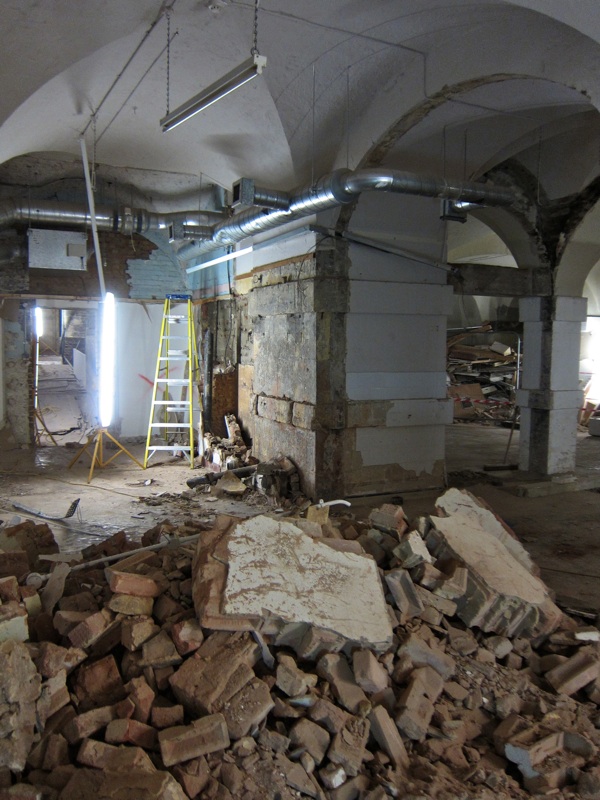In The Crypt Of Christ Church, Spitalfields
For the first time in three centuries, the crypt of Christ Church Spitalfields may be seen with all the dividing walls removed, just as Nicholas Hawksmoor designed it, and last week I was granted the opportunity to photograph this rare vision.
Now the subtlety of Hawksmoor’s geometry is apparent, presenting barrel vaults receding in each direction and proposing a seemingly rational ordered space. Yet a closer examination reveals that the vaults are far from regular and that, as much as the structure of space gives the impression of declaring itself to you, it also conjures a sense of mystery, enfolding you in a forest of columns. The effect is comparable to that of the Basilica Cistern in Istanbul, disorienting the visitor with the feeling you may have entered a labyrinth of infinite recession.
This crypt was filled with the mortal remains of the residents of Spitalfields for centuries. It was not built as a charnel house, but the clergy soon discovered they could capitalise upon the space by renting it out for the storage of the dead, safe from resurrectionists and the travails of time until the day of reckoning. Thus the bulk of the crypt was packed with human remains safely bricked up for eternity.
The remaining space became a refuge for local residents, sleeping there in safety in the company of their forebears while bombs came raining from the sky in the last century. In 1965, it was put to use as a shelter for the homeless and outcast poor who have always gravitated to Spitalfields. This initiative became the Spitalfields Crypt Trust which moved to Shoreditch in 2000, where it continues to offer support and rehabilitation to those in need.
Meanwhile, prior to the restoration of Christ Church, the crypt was excavated and the bodies were transferred to the Natural History Museum, where they remain one of the most significant collections of human remains in forensic and evolutionary studies. In recent years, the crypt has served the parish as a space for meetings, exhibitions and storage for the food bank.
Yet now all the walls accreted over time to serve these purposes have come down and the space has been emptied out – after three hundred years it is now a vacant space again, awaiting new life.
“The crypt at Christ Church has been a place of hospitality, rest, learning and the arts for most of its life in one way or another. The newly developed crypt that will emerge in the Spring of 2015 will continue to be a place of hospitality, rest, learning and the arts. A new lounge, a new hall, gallery spaces and a public refectory open throughout the week will ensure Christ Church Spitalfields is a place of welcome to those who visit from the local community and from the international community. Our prayer is that they would feel welcomed in and blessed by God on their journey through life.” – Andy Rider, Rector of Christ Church
Eighteenth century shroud discovered during the excavations in 1984-1986
Archaeological excavations in the crypt, 1984-86
The crypt was used as a bomb shelter in World War Two
The dormitory of the homeless shelter in the crypt

The cafeteria of the homeless shelter
Recent art installation by Nicholas Feldmeyer

An East End family shelters from the London Blitz in the crypt of Christ Church
Shroud & Excavation Image © Natural History Museum
Archive Images courtesy Christ Church Spitalfields
You may also like to read about
A Brief History of London Crypts
The Secrets of Christ Church Spitalfields
Midwinter Light at Christ Church Spitalfields
A View of Christ Church Spitalfields
Irene Stride Remembers Spitalfields





























Great read. It will be interesting to see what becomes of it and whether it will be at all accessible to the people that used to need it given none of them can afford to live there anymore. The story of the guy sleeping in the coffin is awesome.
Fascinating photos. I know my Mother used the shelter there sometimes during the war, she was living on Hanbury Street cat the time. Valerie
I agree with the first comment, a great read, this is a wonderful space and it is good to know that there are plans to put it to good use. Well done to all those responsible for this.
On a personal level this is an interesting item. My gg-uncle, Jesse Pound, wrote his autobiography in about 1850 and tells of his brother, Giles Murley Pound. “Giles became a very respectable merchant tailor in Kingsland Road, London, where he died a widower about the year 1826, leaving three children and was buried under Shoreditch Church.”
It’s good to see what “under Shoreditch Church” looks like!
Oops – mixed up my churches! The Holfords were buried in Christ Church crypt! Still it is good to see. Any chance of doing St Leonard’s?
I tried to get into the Crypt without walls exhibition too, you know the one known for hospitality and learning. But I was not on the list so couldn’t go in!!
Thank you for the interesting article and excellent pictures. For more information about the crypt and the restoration, visit the Friends’s website http://www.christchurchspitalfields.org
Tonight I visited the crypt for the first time and thought about my Huguenot ancestor who laid there for over two hundred years and now residing elsewhere and the wonder I felt at seeing it in its new use. The refurbishment is just wonderful.